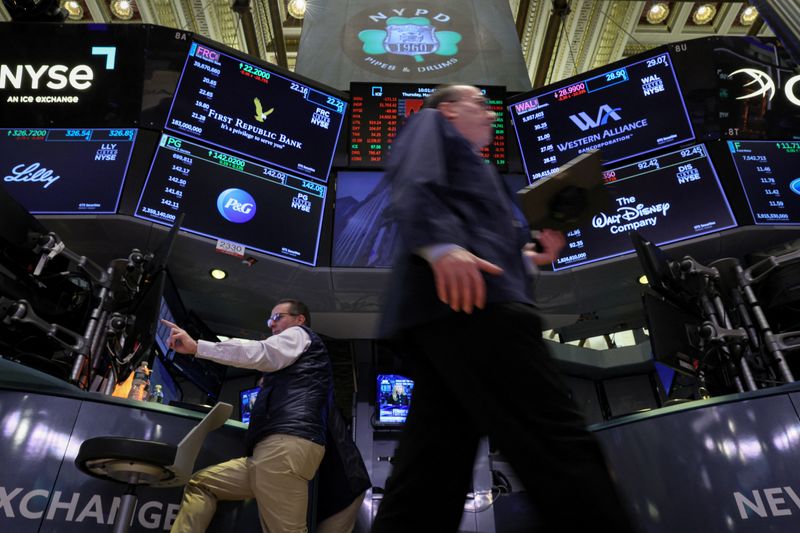United Homes Group stock plunges after Nikki Haley, directors resign
Investing.com - U.S. stock futures wavered on Tuesday after President Donald Trump’s decision to go ahead with tariffs on Canada and Mexico -- and impose an additional 10% levy on China -- weighed heavily on Wall Street. The three countries have vowed to retaliate to the import fees, sparking fears of an escalating global trade war.
1. Futures turn lower
U.S. stock futures hovered below the flatline, reversing earlier gains, after the benchmark S&P 500 slumped to its worst day of the year so far in the prior session.
By 05:45 ET (10:45 GMT), the S&P 500 futures contract had dipped by 9 points or 0.2%, Nasdaq 100 futures had dropped by 11 points or 0.1%, and Dow futures had moved down by 61 points or 0.1%.
The main averages sank on Monday following President Trump’s affirmation that Canada and Mexico would be unable to avoid the imposition of steep -- and previously delayed -- tariffs (more below). China was also hit by a 10% import duty, on top of an earlier 10% trade tax put into effect in February.
In the wake of Trump’s announcement, which erased hopes among investors for an eleventh-hour reprieve, the S&P 500 shed 1.8%, while the tech-heavy Nasdaq Composite fell by 2.6% and the 30-stock Dow Jones Industrial Average retreated by 1.5%.
"Markets have predictably reacted badly, since this raises the risk that Trump will also follow through on his threats to impose reciprocal country-specific tariffs soon, including a proposed 25% on imports from the EU, and product-specific tariffs, on not just steel and aluminum, but semiconductors, pharmaceuticals, other industrial metals and agriculture," said Paul Ashworth, Chief North America Economist at Capital Economics.
2. Trump moves forward with tariffs
Trump’s tariffs on items from Mexico and Canada came into effect at 12:01 AM Eastern time on Tuesday.
The levies, which include a 25% fee on all imports incoming from Mexico and non-energy goods from Canada, were "all set" to go ahead, Trump said on Monday. A 10% surcharge will be collected on Canadian energy as well.
America’s southern and northern neighbors had earlier raced to appease Trump’s call for increased border security to help stem the flow of the illegal drug fentanyl and migrants into the U.S. Concessions offered in February led to a month-long postponement of the duties.
However, Trump said the countries had still not done enough to address his demands, adding that there was "no room left" for a deal to be secured. China had also not taken "adequate steps to alleviate the illicit drug crisis," Trump said.
Economists and company executives have long argued that the tariffs on Canada and Mexico -- which make up $900 billion in annual U.S. imports -- threaten to upend a deeply-integrated North American economy. Along with China, Canada and Mexico account for more than 40% of total U.S. imports.
The tariffs on Canada and Mexico could lift core consumer prices in the U.S. by 0.6%, while the extra levies on China could push up prices by 0.1%, according to Goldman Sachs analysts. The prospect of Trump’s trade stance reigniting inflationary pressures has been a key concern for the Federal Reserve, with the central bank signaling that it will adopt a careful approach to future potential interest rate cuts as policymakers assess the impact of the tariffs.
3. Tariff retaliations promised
Canada’s Prime Minister Justin Trudeau said Ottawa would respond to Trump’s tariffs by introducing its own 25% levy on roughly $20 billion in U.S. goods, after previously saying the measures would target specific items like American beer, bourbon, wine, orange juice and home appliances.
Should the U.S. levies remain in place for 21 days, another duty on about $86 billion in American goods would be implemented, Trudeau said.
"Tariffs will disrupt an incredibly successful trading relationship,” Trudeau said, adding that Americans will end up paying more for items like groceries and gas because of them.
Mexican leader Claudia Sheinbaum has said the country has a "plan B, C, D" to respond to the tariffs, although no moves were immediately announced.
Meanwhile, China’s commerce ministry said on Tuesday that it would roll out additional 10%-15% tariffs on certain U.S. imports from March 10, calling Trump’s levies "unreasonable and groundless" as well as "harmless to others."
Stock markets in Asia slumped on Tuesday, mirroring the declines on Wall Street.
4. Target , Best Buy earnings ahead
On the earnings calendar, retailers Target (NYSE:TGT) and Best Buy (NYSE:BBY) are due to report their results before the opening bell on Tuesday, with the companies’ forward guidance possibly offering a glimpse into the state of consumer spending.
Recent data has shown that sentiment among U.S. shoppers has slumped to a 15-month low, as households and businesses fret over the implications of Trump’s tariffs on prices.
Figures last week found that consumer expenditures also fell for the first time in almost two years in January, while inflation expectations soared.
The numbers have pointed to possible sluggishness -- or even contraction -- in the U.S. economy in the first quarter. The Atlanta Fed’s GDPNow model now sees annualized growth in the current quarter at -2.8%, reversing from +2.3% last week.
5. Bitcoin slides
Bitcoin slid on Tuesday, extending losses from the prior session as a short-lived rally, as risk appetite was rattled by Trump’s tariffs.
The world’s largest cryptocurrency tumbled back in sight of a four-month low, while major altcoins also clocked heavy losses, largely reversing all gains made on Monday following recent comments from Trump about a strategic crypto reserve.
Elsewhere, the price of gold, which is typically viewed as a safe haven asset, ticked higher. The Canadian dollar and Mexican peso also weakened to their lowest levels in a month, and oil prices slipped down to almost three-month lows.
